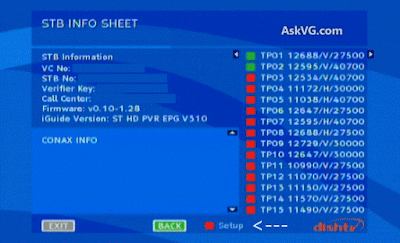Dish Tv Set Top Box Software Update

Hello Friends!! As you know, sometime set-top box firmware/software bricks due to power fluctuations, wrong firmware upgrade or incomplete dump process. Dishtv software update manual Method. Hi i got the process for updating dish tv software from my dealer friend and i tried it with my aunt dishtv stb and it works. Check it out: plz note that u have to perform this process while ur stb is on. 1) press channel up (^) button three times on ur stb and then previous button on remote.
A consumer Palcom DSL-350 satellite-receiver; the tuner is on the bottom left, and a decoder is in the center of the board. The is on the right. The signal source might be an cable, a, a (see ), a line (including connections), (BPL), or even an ordinary. Content, in this context, could mean any or all of,,,, or other possibilities. Satellite and microwave-based services also require specific external receiver hardware, so the use of set-top boxes of various formats has never completely disappeared. Set-top boxes can also enhance source signal quality.
UHF converter [ ] Before the of 1962 required US to be able to tune the entire and range (which in was channels on 54 to 890 ), a set-top box known as a UHF converter would be installed at the receiver to shift a portion of the UHF-TV spectrum onto low-VHF channels for viewing. As some 1960s-era 12-channel TV sets remained in use for many years, and and were slower than the US to require UHF tuners to be factory-installed in new TVs, a market for these converters continued to exist for much of the 1970s. Cable converter [ ]. Main article: represented a possible alternative to deployment of UHF converters as broadcasts could be frequency-shifted to VHF channels at the cable head-end instead of the final viewing location. However, most cable systems could not accommodate the full 54-890 MHz VHF/UHF frequency range and the twelve channels of VHF space were quickly exhausted on most systems. Adding any additional channels therefore needed to be done by inserting the extra signals into cable systems on nonstandard frequencies, typically either below VHF (midband) or directly above VHF channel 13 (superband). These frequencies corresponded to non-television services (such as two-way radio) over-the-air and were therefore not on standard TV receivers. Lo 1 1b Flaming Cliffs Setup Wizard.

Before cable-ready TV sets became common in the late 1980s, an electronic tuning device called a was needed to receive the additional and transpose or convert the selected channel to (RF) for viewing on a regular TV set on a single channel, usually channel 3 or 4. The box allowed an analog non-cable-ready set to receive analog encrypted cable channels and was a prototype topology for later date digital encryption devices. Newer televisions were then converted to be analog cypher cable-ready, with the standard converter built-in for selling (aka ). Several years later and slowly marketed, the advent of continued and increased the need for various forms of these devices. Of the entire affected frequency band onto, while less common, was used by some models to provide full compatibility and the ability to drive multiple TV sets, albeit with a somewhat nonstandard channel numbering scheme. Newer television receivers greatly reduced the need for external set-top boxes, although continue to be used to premium cable channels according to carrier-controlled access restrictions, and to receive digital cable channels, along with using interactive services like, pay per view, and through television.